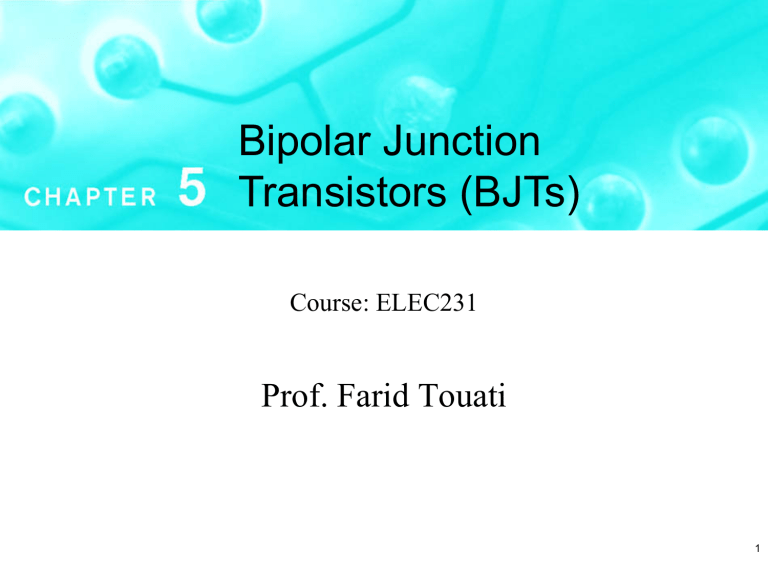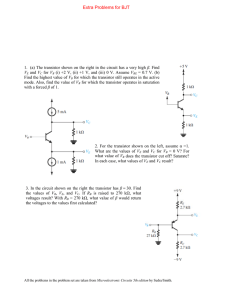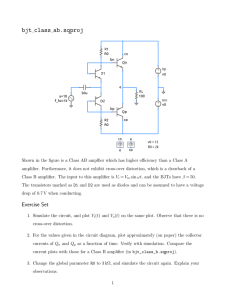
Bipolar Junction Transistors (BJTs) Course: ELEC231 Prof. Farid Touati 1 5.1 DEVICE STRUCTUE & MODES OF OPERATION Figure 5.1 A simplified structure of the npn transistor. Figure 5.2 A simplified structure of the pnp transistor. Microelectronic Circuits - Fifth Edition Sedra/Smith Copyright © 2004 by Oxford University Press, Inc. 2 Active Mode for an NPN BJT Compare with MOSFET…. Figure 5.3 Current flow in an npn transistor biased to operate in the active mode. (Reverse current components due to drift of thermally generated minority carriers are not shown.) Microelectronic Circuits - Fifth Edition Sedra/Smith Copyright © 2004 by Oxford University Press, Inc. 3 Modes of Operation MODE EBJ CBJ Cutoff Reverse Reverse Active Forward Reverse Saturation Forward Forward Microelectronic Circuits - Fifth Edition Sedra/Smith Copyright © 2004 by Oxford University Press, Inc. 4 Large-Signal Equivalent Circuit in the NPN Active Mode Current Equations iB = iC β , iC = I S e vbe / VT iE = iC + iB → iE = αiC Figure 5.5 Large-signal equivalent-circuit models of the npn BJT operating in the forward active mode. Microelectronic Circuits - Fifth Edition Sedra/Smith Copyright © 2004 by Oxford University Press, Inc. 5 Large-Signal Equivalent Circuit in the NPN Reverse Mode Figure 5.7 Model for the npn transistor when operated in the reverse active mode (i.e., with the CBJ forward biased and the EBJ reverse biased). Microelectronic Circuits - Fifth Edition Sedra/Smith Copyright © 2004 by Oxford University Press, Inc. 6 Active Mode for an PNP BJT Figure 5.11 Current flow in a pnp transistor biased to operate in the active mode. Microelectronic Circuits - Fifth Edition Sedra/Smith Copyright © 2004 by Oxford University Press, Inc. 7 Large-Signal Equivalent Circuit in the PNP Active Mode Figure 5.12 Large-signal model for the pnp transistor operating in the active mode. Microelectronic Circuits - Fifth Edition Sedra/Smith Copyright © 2004 by Oxford University Press, Inc. 8 CIRCUIT SYMBOLS AND CONVENTIONS Figure 5.13 Circuit symbols for BJTs. Microelectronic Circuits - Fifth Edition Sedra/Smith Copyright © 2004 by Oxford University Press, Inc. 9 VOLTAGE POLARITY AND CURRENT FLOW Figure 5.14 Voltage polarities and current flow in transistors biased in the active mode. Microelectronic Circuits - Fifth Edition Sedra/Smith Copyright © 2004 by Oxford University Press, Inc. 10 NPN BJT large-signal models Active Microelectronic Circuits - Fifth Edition Sedra/Smith Copyright © 2004 by Oxford University Press, Inc. 11 Saturation Microelectronic Circuits - Fifth Edition Sedra/Smith Copyright © 2004 by Oxford University Press, Inc. 12 Cutoff Microelectronic Circuits - Fifth Edition Sedra/Smith Copyright © 2004 by Oxford University Press, Inc. 13 GRAPHICAL REPRESENTATION OF BJT CHARACTERISITCS iC-vBE curve compare with iD-vGS See Example 5.10 on this! Figure 5.16 The iC –vBE characteristic for an npn transistor. Microelectronic Circuits - Fifth Edition Sedra/Smith Figure 5.17 Effect of temperature on the iC–vBE characteristic. At a constant emitter current (broken line), vBE changes by –2 mV/°C. Copyright © 2004 by Oxford University Press, Inc. 14 EXAMPLE 5.1 VBE=0.7V @ iC=1mA, β=100. Design the circuit so that iC=2mA and VC=5V. Figure 5.15 Circuit for Example 5.1. Microelectronic Circuits - Fifth Edition Sedra/Smith Solve graphically…. Copyright © 2004 by Oxford University Press, Inc. 15 BJT biased in Active Region Microelectronic Circuits - Fifth Edition Sedra/Smith BJT biased in Saturation or Cutoff Region Copyright © 2004 by Oxford University Press, Inc. 16 EXAMPLE 5.4 Determine all nodes voltage, β=100. Check for active mode ONBOARD…. Figure 5.34 Analysis of the circuit for Example 5.4: (a) circuit; (b) circuit redrawn to remind the reader of the convention used in this book to show connections to the power supply; (c) analysis with the steps numbered. Microelectronic Circuits - Fifth Edition Sedra/Smith Copyright © 2004 by Oxford University Press, Inc. 17 EXAMPLE 5.5 Determine all nodes voltage, β=100. Check for active mode DO IT YOURSELF! Figure 5.35 Analysis of the circuit for Example 5.5. Note that the circled numbers indicate the order of the analysis steps. Microelectronic Circuits - Fifth Edition Sedra/Smith Copyright © 2004 by Oxford University Press, Inc. 18 EXAMPLE 5.6 Determine all nodes voltage, β=100. Check for active mode DO IT YOURSELF! Figure 5.36 Example 5.6: (a) circuit; (b) analysis with the order of the analysis steps indicated by circled numbers. Microelectronic Circuits - Fifth Edition Sedra/Smith Copyright © 2004 by Oxford University Press, Inc. 19 EXAMPLE 5.8 Determine all nodes voltage, β=100. Check for active mode DO IT YOURSELF! T rises à Ib & Ic increase à Q unstable à solution?? Figure 5.38 Example 5.8: (a) circuit; (b) analysis with the steps indicated by the circled numbers. Microelectronic Circuits - Fifth Edition Sedra/Smith Copyright © 2004 by Oxford University Press, Inc. 20 EXAMPLE 5.10 Determine all nodes voltage, β=100. Check for active mode ONBOARD…. Stable BIASING! Q is independent of β Q is stable also! Figure 5.40 Circuits for Example 5.10. Microelectronic Circuits - Fifth Edition Sedra/Smith Copyright © 2004 by Oxford University Press, Inc. 21 BIASING SCHEMES Figure 5.43 Two obvious schemes for biasing the BJT: (a) by fixing VBE; (b) by fixing IB. Both result in wide variations in IC and hence in VCE and therefore are considered to be “bad.” Neither scheme is recommended. Microelectronic Circuits - Fifth Edition Sedra/Smith Copyright © 2004 by Oxford University Press, Inc. 22 BIASING USING TWO POWER SUPPLIES Figure 5.45 Biasing the BJT using two power supplies. Resistor RB is needed only if the signal is to be capacitively coupled to the base. Otherwise, the base can be connected directly to ground, or to a grounded signal source, resulting in almost total β-independence of the bias current. Microelectronic Circuits - Fifth Edition Sedra/Smith Copyright © 2004 by Oxford University Press, Inc. 23 BIASING USING FEEDBACK R Figure 5.46 (a) A common-emitter transistor amplifier biased by a feedback resistor RB. (b) Analysis of the circuit in (a). Microelectronic Circuits - Fifth Edition Sedra/Smith Copyright © 2004 by Oxford University Press, Inc. 24 BIASING USING A CONSTANT CURRENT SOURCE Figure 5.47 (a) A BJT biased using a constant-current source I. (b) Circuit for implementing the current source I. Microelectronic Circuits - Fifth Edition Sedra/Smith Copyright © 2004 by Oxford University Press, Inc. 25 SMALL-SIGNAL OPERATION AND MODELS Figure 5.48 (a) Conceptual circuit to illustrate the operation of the transistor as an amplifier. (b) The circuit of (a) with the signal source vbe eliminated for dc (bias) analysis. Microelectronic Circuits - Fifth Edition Sedra/Smith Copyright © 2004 by Oxford University Press, Inc. 26 CE Amplifier Transfer Characteristic Logic Inverter….. Can you see! Figure 5.26 (a) Basic common-emitter amplifier circuit. (b) Transfer characteristic of the circuit in (a). The amplifier is biased at a point Q, and a small voltage signal vi is superimposed on the dc bias voltage VBE. The resulting output signal vo appears superimposed on the dc collector voltage VCE. The amplitude of vo is larger than that of vi by the voltage gain Av. Microelectronic Circuits - Fifth Edition Sedra/Smith Copyright © 2004 by Oxford University Press, Inc. 27 BJT transconductance gm ∂iC gm = ∂vBE iC = I C IC = VT Figure 5.49 Linear operation of the transistor under the small-signal condition: A small signal vbe with a triangular waveform is superimposed on the dc voltage VBE. It gives rise to a collector signal current ic, also of triangular waveform, superimposed on the dc current IC. Here, ic = gmvbe, where gm is the slope of the iC–vBE curve at the bias point Q. Microelectronic Circuits - Fifth Edition Sedra/Smith Copyright © 2004 by Oxford University Press, Inc. 28 The Hybrid-π Model Figure 5.50 The amplifier circuit of Fig. 5.48(a) with the dc sources (VBE and VCC) eliminated (short circuited). Thus only the signal components are present. Note that this is a representation of the signal operation of the BJT and not an actual amplifier circuit. Microelectronic Circuits - Fifth Edition Sedra/Smith Copyright © 2004 by Oxford University Press, Inc. 29 Figure 5.51 Two slightly different versions of the simplified hybrid-π model for the small-signal operation of the BJT. The equivalent circuit in (a) represents the BJT as a voltage-controlled current source (a transconductance amplifier), and that in (b) represents the BJT as a currentcontrolled current source (a current amplifier). Microelectronic Circuits - Fifth Edition Sedra/Smith Copyright © 2004 by Oxford University Press, Inc. 30 The T Model Figure 5.52 Two slightly different versions of what is known as the T model of the BJT. The circuit in (a) is a voltage-controlled current source representation and that in (b) is a current-controlled current source representation. These models explicitly show the emitter resistance re rather than the base resistance rπ featured in the hybrid-π model. Microelectronic Circuits - Fifth Edition Sedra/Smith Copyright © 2004 by Oxford University Press, Inc. 31 Application of the Small-Signal Equivalent Circuits The process of analysis of BJT amps consists of: 1. Determine the Bias conditions (e.g. IC) 2. Calculate the values of the small-signal model parameters: gm=IC/VT, rπ=β/gm, and re=VT/IE=α/ gm 3. Short all dc voltage sources and open all dc current sources. 4. Replace the transistor by one of its models. 5. Analyze the resulting circuit to find the required quantities (voltage/current gain, i/p and o/p resistance, etc… Microelectronic Circuits - Fifth Edition Sedra/Smith Copyright © 2004 by Oxford University Press, Inc. 32 Example 5.14 Analyze the circuit below to find its Av, Avo, Rin, Ro, Ai. Assume β=100 and VT=25mV On Board….. Figure 5.53 Example 5.14: (a) circuit; (b) dc analysis; (c) small-signal model. Microelectronic Circuits - Fifth Edition Sedra/Smith Copyright © 2004 by Oxford University Press, Inc. 33 Constraint: vbe < 10mV à vi<0.91V àvC=vO< 2.77V We took vipeak=0.8V àibpeak=0.008mA, vbe,peak= 8.6mV à icpeak=8mA, vcpeak=2.43V. Figure 5.54 Signal waveforms in the circuit of Fig. 5.53. Microelectronic Circuits - Fifth Edition Sedra/Smith Copyright © 2004 by Oxford University Press, Inc. 34 Augmenting the Small-Signal Models to account for the Early effect. The iC-vCE Curve and the Early Voltage VA −1 ⎡ ∂i ⎤ ro = ⎢ C vBE = cons tan t ⎥ , ⎣ ∂vCE ⎦ ro ≅ VA IC Figure 5.58 The hybrid-π small-signal model, in its two versions, with the resistance ro included. Microelectronic Circuits - Fifth Edition Sedra/Smith Copyright © 2004 by Oxford University Press, Inc. 35 The Common-Emitter (CE) BJT Amplifier Figure 5.60 (a) A common-emitter amplifier using the structure of Fig. 5.59. (b) Equivalent circuit obtained by replacing the transistor with its hybrid-π model. Microelectronic Circuits - Fifth Edition Sedra/Smith Copyright © 2004 by Oxford University Press, Inc. 36 The CE BJT Amplifier with Emitter R Figure 5.61 (a) A common-emitter amplifier with an emitter resistance Re. (b) Equivalent circuit obtained by replacing the transistor with its T model. Microelectronic Circuits - Fifth Edition Sedra/Smith Copyright © 2004 by Oxford University Press, Inc. 37 The Common-Base (CB) BJT Amplifier Figure 5.62 (a) A common-base amplifier using the structure of Fig. 5.59. (b) Equivalent circuit obtained by replacing the transistor with its T model. Microelectronic Circuits - Fifth Edition Sedra/Smith Copyright © 2004 by Oxford University Press, Inc. 38 The CC or Emitter-Follower BJT Amplifier Figure 5.63 (a) An emitter-follower circuit based on the structure of Fig. 5.59. (b) Small-signal equivalent circuit of the emitter follower with the transistor replaced by its T model augmented with ro. (c) The circuit in (b) redrawn to emphasize that ro is in parallel with RL. This simplifies the analysis considerably. Microelectronic Circuits - Fifth Edition Sedra/Smith Copyright © 2004 by Oxford University Press, Inc. 39 Figure 5.64 (a) An equivalent circuit of the emitter follower obtained from the circuit in Fig. 5.63(c) by reflecting all resistances in the emitter to the base side. (b) The circuit in (a) after application of Thévenin theorem to the input circuit composed of vsig, Rsig, and RB. Microelectronic Circuits - Fifth Edition Sedra/Smith Copyright © 2004 by Oxford University Press, Inc. 40 Figure 5.65 (a) An alternate equivalent circuit of the emitter follower obtained by reflecting all base-circuit resistances to the emitter side. (b) The circuit in (a) after application of Thévenin theorem to the input circuit composed of vsig, Rsig / (β 1 1), and RB / (β 1 1). Microelectronic Circuits - Fifth Edition Sedra/Smith Copyright © 2004 by Oxford University Press, Inc. 41 Figure 5.66 Thévenin equivalent circuit of the output of the emitter follower of Fig. 5.63(a). This circuit can be used to find vo and hence the overall voltage gain vo/vsig for any desired RL. Microelectronic Circuits - Fifth Edition Sedra/Smith Copyright © 2004 by Oxford University Press, Inc. 42


